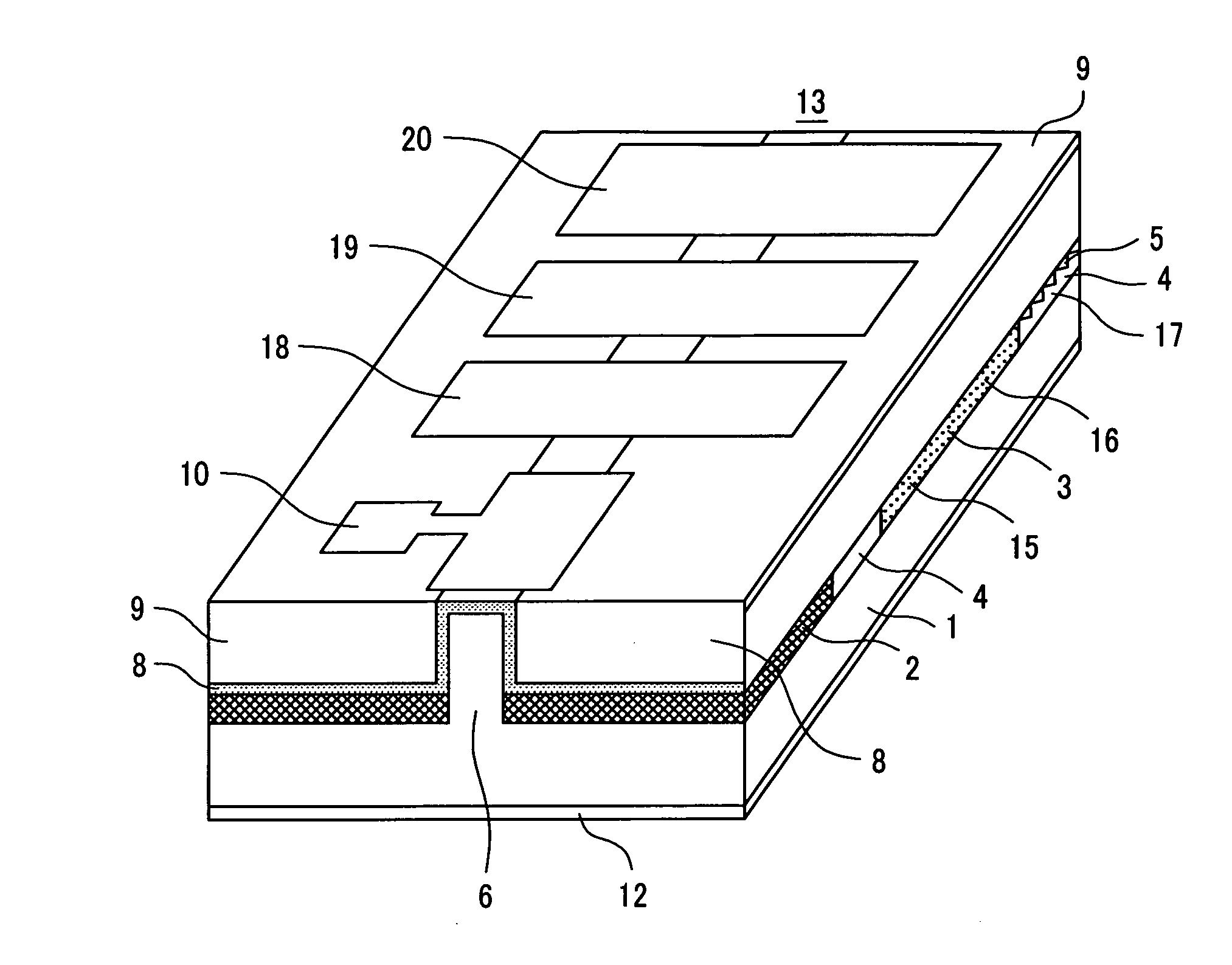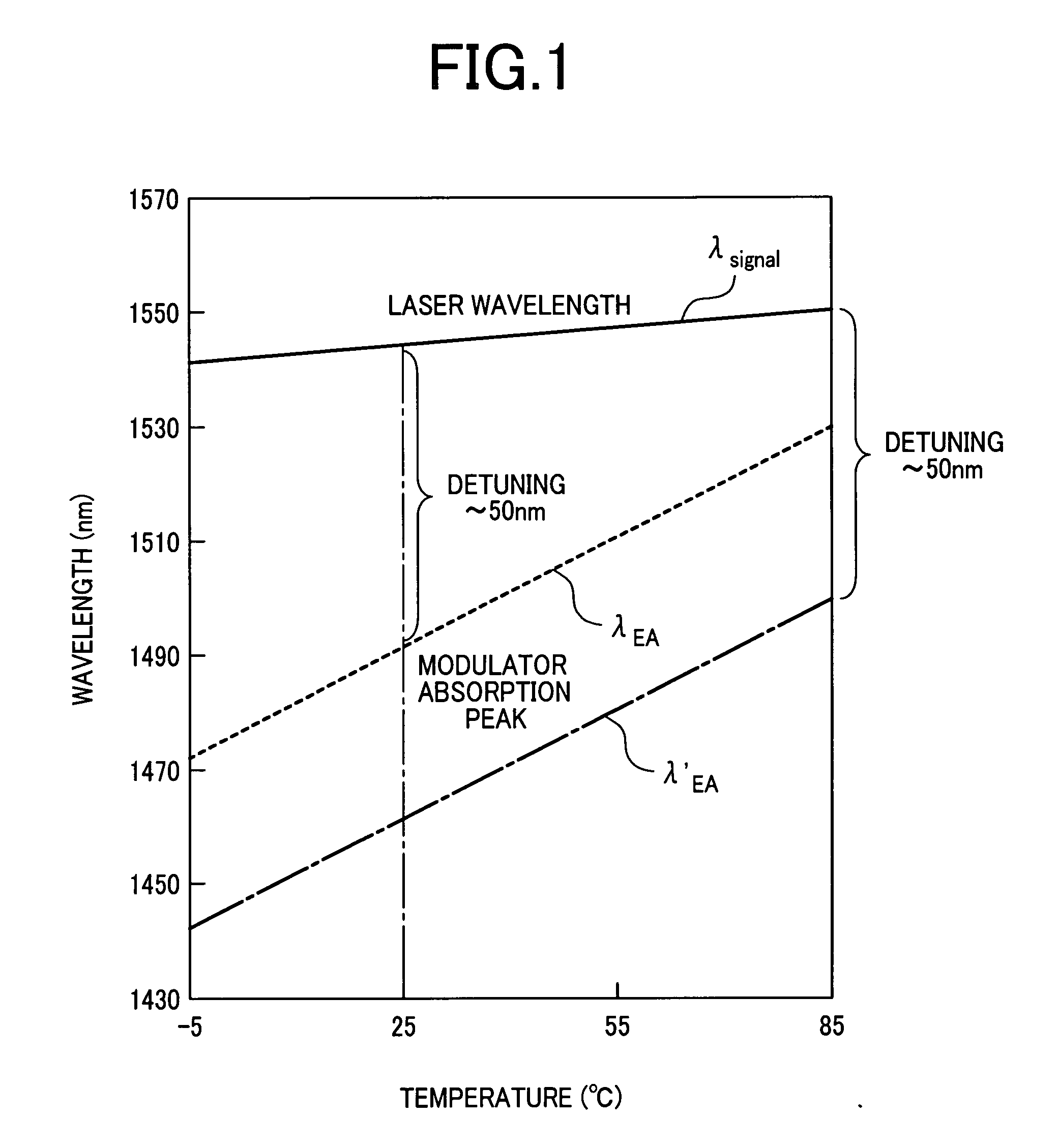Semiconductor optical modulation device
a technology of optical modulation and semiconductor, applied in the direction of optics, semiconductor lasers, instruments, etc., can solve the problems of difficult to achieve long distance transmission for a distance of 40 km or more by uncooled operation, and the method is not suitable for the operation in the 1550 nm band of signal light wavelength
- Summary
- Abstract
- Description
- Claims
- Application Information
AI Technical Summary
Benefits of technology
Problems solved by technology
Method used
Image
Examples
embodiment 1
RWG-EA / DFB (DBR)
[0054] A process for manufacturing a semiconductor optical integrated device according to Embodiment 1 of the present invention is described with reference to FIG. 5 and FIG. 6. The drawings are only for the purpose of explaining the embodiment. The size and scale of the drawings showing the embodiment are not necessarily identical.
[0055] At first, a quantum well structure 2 made of an InGaAlAs system is formed on an n-InP substrate 1 as an electro-absorption optical modulator using an MOCVD method (FIG. 5A). In this case, a light emission wavelength of the quantum well structure at a temperature of 25° C. is about 1470 nm. For example, a desired light emission wavelength can be obtained by laminating a quantum well layer with a thickness of 6 nm and with a compositional ratio of In, Ga, and Al at 0.54:0.38:0.08, and a barrier layer with a thickness of 10 nm and with a compositional ratio of In, Ga, and Al at 0.52:0.33:0.15. Further, an optical confinement structur...
embodiment 2
BH-EA / DFB (DBR)
[0070]FIG. 7A is a perspective view illustrating a construction according to another embodiment of a semiconductor optical integrated device applied with the present invention. FIG. 7B is a perspective view illustrating a cross section cut along a central line. However, the drawing is only for explaining this embodiment and the size and scale of the drawing showing this embodiment are not necessarily identical.
[0071] At first, a quantum well structure 2 made of an InGaAlAs system is formed on an n-InP substrate 1 as an electro-absorption optical modulator using an MOCVD method. In this case, a light emission wavelength of the quantum well structure 2 at a temperature of 25° C. is about 1470 nm. For example, a desired light emission wavelength can be obtained by laminating a quantum well layer with a thickness of 6 nm and with a compositional ratio of In, Ga, and Al at 0.54:0.38:0.08, and a barrier layer with a thickness of 10 nm and with a compositional ratio of In,...
embodiment 3
RWG-EA / Variable Wavelength LD
[0085]FIG. 8A is a perspective view showing the constitution according to another embodiment of a semiconductor optical integrated device formed as a variable wavelength LD applied to the present invention. FIG. 8B is a perspective view illustrating a cross section cut along a central line. Figures for the processes shown in FIGS. 5 and 6 in Embodiment 1 are not illustrated. However, the drawing is only for the explanation of this embodiment and the size and scale of the drawing showing this embodiment are not necessarily identical.
[0086] A quantum well structure 2 made of an InGaAlAs system is formed on an n-InP substrate 1 as an electro-absorption optical modulator using an MOCVD method. In this case, a light emission wavelength of the quantum well structure at a temperature of 25° C. is about 1470 nm. For example, a desired light emission wavelength can be obtained by forming a quantum well layer with a thickness of 6 nm and with a compositional rat...
PUM
 Login to View More
Login to View More Abstract
Description
Claims
Application Information
 Login to View More
Login to View More - R&D
- Intellectual Property
- Life Sciences
- Materials
- Tech Scout
- Unparalleled Data Quality
- Higher Quality Content
- 60% Fewer Hallucinations
Browse by: Latest US Patents, China's latest patents, Technical Efficacy Thesaurus, Application Domain, Technology Topic, Popular Technical Reports.
© 2025 PatSnap. All rights reserved.Legal|Privacy policy|Modern Slavery Act Transparency Statement|Sitemap|About US| Contact US: help@patsnap.com



